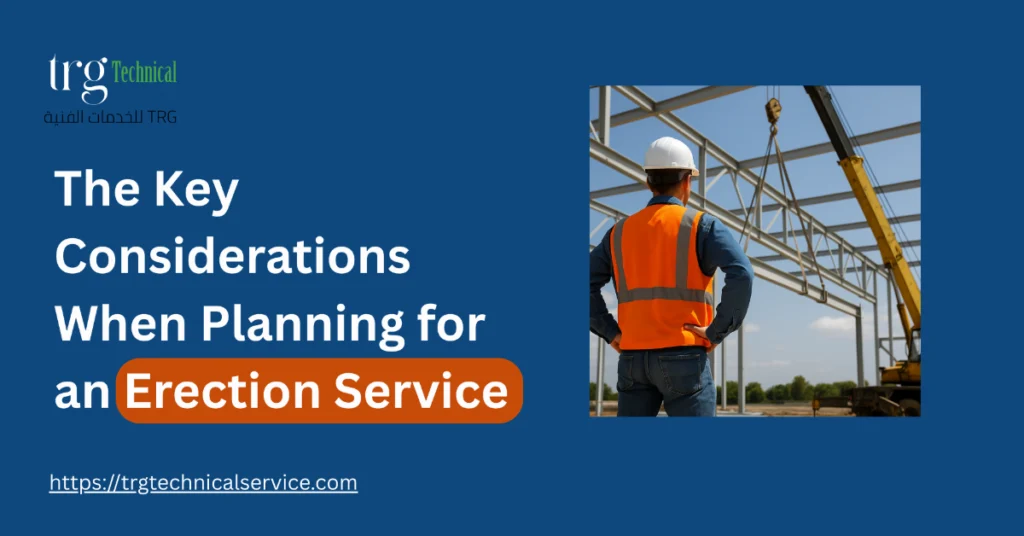The Key Considerations When Planning for an Erection Service

When it comes to construction or industrial projects, erection services the process of assembling and installing steel structures, machinery, or heavy equipment are critical to project success. A well-planned erection process ensures that your structures are safe, stable, and ready for long-term use. Poor planning, on the other hand, can lead to delays, safety hazards, and costly rework.
Whether you’re preparing for a steel structure erection, a mechanical installation, or industrial equipment assembly, here are the key factors to consider when planning your project.
1. Define the Scope and Requirements Early
Before any on-site work begins, clarity on the scope of the erection service is essential. Ask yourself:
What structure or equipment needs to be erected?
What are the load, height, and design specifications?
Are there any special environmental or site conditions to consider?
Does the structure require temporary support or staging?
Having a detailed scope document helps both your internal team and the erection contractor plan resources, manpower, and timelines more accurately.
2. Choose the Right Erection Service Provider
Erection services are highly specialized, requiring technical expertise and strict safety compliance. Partnering with the right contractor can make or break your project.
When evaluating a service provider, consider:
Experience with similar projects (industrial plants, steel structures, machinery installations)
Certifications and safety records
Availability of specialized equipment, such as cranes, scaffolding, or rigging tools
Qualified and certified manpower, including riggers and welders
A professional team will not only execute the work but also guide you on risk mitigation and compliance requirements.
3. Conduct a Site Assessment
Every site comes with unique challenges. Before the erection process begins, a thorough site inspection is crucial to identify:
Ground stability and load-bearing capacity for cranes and heavy equipment
Access routes for large components and machinery
Weather conditions that may affect lifting and assembly
Existing utilities and obstructions like power lines, pipelines, or tight spaces
By identifying these challenges early, you can plan site preparation, temporary roadways, or lifting strategies to avoid delays.
4. Plan for Lifting and Rigging Operations
Heavy components like steel beams, trusses, or machinery often require complex lifting operations. A miscalculation here can result in severe safety incidents or structural damage.
Key considerations include:
Crane selection and placement
Weight and load calculations for each lift
Rigging and lifting accessories like slings, shackles, and spreader bars
Wind and weather conditions during lifting operations
A detailed lifting plan is mandatory to ensure all movements are safe and coordinated.
5. Safety and Compliance Should Be Non-Negotiable
Erection services involve high-risk activities like working at heights, lifting heavy loads, and using cranes. Safety must be at the center of every plan.
Ensure all personnel are trained and equipped with PPE
Comply with local occupational safety standards and site-specific protocols
Conduct daily toolbox talks and risk assessments
Have an emergency response plan in place
Partnering with a safety-conscious contractor can prevent accidents and costly downtime.
6. Schedule and Coordinate Logistics
Erection work often happens in tight windows, especially if it’s part of a larger construction timeline. Delays in component delivery or crane availability can disrupt the entire project.
Make sure to:
Confirm delivery dates for steel components, prefabricated parts, or equipment
Coordinate storage and staging areas for materials
Align contractor schedules with other ongoing construction activities
Prepare backup plans for weather or supply chain delays
Proper logistics ensure smooth assembly without idle labor or machinery costs.
7. Monitor Quality Control Throughout the Process
Inspection and quality checks should happen during the erection process, not just after completion. This includes:
Verifying alignments and dimensions
Inspecting welds and bolted connections
Checking foundation and anchoring accuracy
Documenting every stage for compliance and future maintenance
Catching errors early saves time and prevents structural issues later.
8. Plan for Post-Erection Inspection and Handover
Once the structure or equipment is in place:
Conduct a final inspection for alignment, stability, and compliance
Ensure all temporary supports or rigging are safely removed
Prepare as-built documentation and reports
Complete a formal handover to the project owner or client
This final step confirms the erection service was executed safely, correctly, and to specification.
Conclusion
Planning an erection service is about much more than just assembling components it’s about strategic preparation, safety, and precision. From choosing the right contractor to ensuring proper lifting plans and quality checks, every detail matters.
For expert erection and technical services in the UAE, partner with TRG Technical Services. Our experienced team ensures safe, efficient, and cost-effective erection solutions for industrial, commercial, and residential projects.


